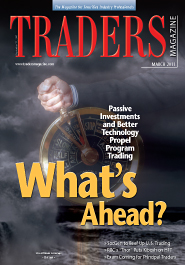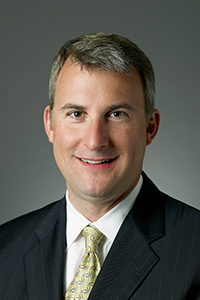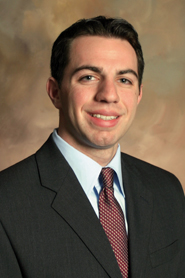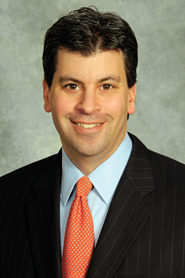Program trading is in again. Its volumes have been rising. Its technology is becoming more sophisticated. And the buyside is warming to its capabilities, so much so that program trading now represents roughly 15 percent of U.S. equities volume. This is a jump of 50 percent in just one year, according to a recent industry study.

Among the players on the equities stage over the past decade, program trading was always the character actor–never the lead, the villain or even the sidekick. Content to plod along in the background in its essential yet workmanlike role, it has performed quietly while algorithms, single-stock blocks, direct market access, dark pools and high-frequency trading grabbed all of the headlines, fame and notoriety.
See Sidebar: Swaps and Programs
But now program trading may be getting ready for its close-up. Last year, traders executed many more shares in baskets than they did one year earlier. Strategic and technological changes at institutions are behind the increase. Brokers have noticed.
"We have seen a steady increase in volumes in the portfolio business," said Jason D. Crosby, head of portfolio products in the Americas at Morgan Stanley.
And he isn’t alone.
"In 2010, we saw an increase in [program trading] volume overall, compared to the previous year," said Jeffrey Radtke, global head of program trading at Barclays Capital. "But what we saw was a change in the liquidity profile. In terms of index funds and the investment, we noticed over the last year movement from active funds into passive index funds."
In fact, that change in institutions’ investment strategies led to more portfolio trading, program desk execs said. In addition, buyside traders drove program volumes higher by becoming more comfortable using newer and more powerful portfolio trading tools.
Program trading is roughly synonymous with portfolio trading and basket trading. The New York Stock Exchange describes a program trade as any strategy that involves the purchase or sale of a basket of at least 15 stocks. But with different market participants using strategies that include basket-size orders–such as HFTs–the definition may need an overhaul, said John Carillo, who heads portfolio trading at ITG.
Regardless, buyside traders told the Tabb Group for its 2010/2011 study on U.S. equities trading that they allocated 15 percent of their order flow to programs last year. That compares with 10 percent the buyside allocated in 2009. For the study, Tabb spoke to the head traders at 68 long-only asset management firms in September and October last year.
The study’s author, Senior Analyst Matthew Simon, said much of the increase has to do with a change in methodology for measuring program trading, and how the buyside has been using improved program trading algorithms to execute orders. But the new methodology does not hide the fact that more of the buyside’s orders are being executed as portfolio trades, he added, whether by its own traders using algos or by brokers’ sales desks.
Indespensable Tool
Brokerages who spoke to Traders Magazine also said their program trading numbers climbed noticeably in 2010. But they declined to provide specific numbers or estimated percentages to show how much growth their respective desks saw.
Volume growth aside, trading baskets has always had a place in the equities markets and always will, Carillo said, because it fills a need. "Program trading as a tool is an indispensable part of pretty much every type of client’s work flow," he said. "You can look at a hedge fund client, a passive index provider, a quantitative manager, an active manager. Each one has a different reason for needing tools to trade lists of stocks."
The need became more apparent in the wake of the financial crisis in 2008. It continued through last year’s flash crash on May 6. Since the crisis struck, many investors have lost confidence in U.S. equities, the foundation of many active managers’ funds.
Subsequently, many investors shifted to strategies that were more passive–or index-based–in nature, as well as more global in scope, Morgan Stanley’s Crosby said. They embraced financial instruments, particularly exchange-traded funds and also swaps (see sidebar), that helped them gain exposure to other markets. And ETFs and swaps lend themselves well to program trading.
"When investors want to maintain exposure to equities without engaging in active stock selection, clearly one of the options is index-based products," Crosby said. "We saw an increase of flow into passive indexes from more actively managed funds last year."

The data reflect this. Net new cash flows have been exiting domestic equity funds since 2006, according to the Investment Company Institute. Last year showed more of the same, as almost $103 billion left domestic equities. Assets in domestic equity funds–at $3.46 trillion–stand at roughly 83 percent of their 2007 high of almost $4.2 trillion.
Yet total net new cash flows into domestic and global equity index funds have jumped almost 78 percent since 2006. The ICI does not track how much of those funds have gone into ETFs. But since 2005, total net assets in ETFs have more than trebled, from roughly $300 billion to just under $1 trillion.
Nevertheless, index funds aren’t in any way pulling even with active funds. By the end of 2010, total net new cash flows into active funds still amounted to more than three times the total for index funds, ICI figures showed.
The shift in investment flows is not necessarily good news for the buyside. Fees for passive investment are much less than those for active management.
The average annual report net expense ratio for passive U.S. open-end mutual funds is 0.64, while the average annual report net expense ratio for active U.S. open-end mutual funds is 1.23, according to investment research provider Morningstar. The expense ratio includes fund operating expenses and management fees, but does not include brokerage costs.
The marked increase in asset allocations into ETFs and international markets led to a growing portfolio-based business in 2010. This is because more ETFs mean more trading opportunities for portfolio desks. The desks must buy the underlying stocks for the ETF create process on a global scale. Going through a program desk is the most efficient way to implement sector- and capitalization-based strategies, Crosby said. The desks have global connectivity and the ability to settle as a single basket with performance numbers.
Light Volatility
From a macro-asset allocation perspective, the credit crisis prompted a flight to fixed income, Crosby said. As those assets start coming back into equities, one of the early benefactors of this migration was passive products, until investors get enough information to form a clearer picture to select stocks, he added.
Volatility was light for much of 2010. In addition, the market correlation was higher, meaning that many stocks or sectors tended to move more often in tandem. In such an environment, index-based and ETF investing in equities made more sense to risk-averse investors seeking to increase market exposure, said Mike Lawsky, UBS’s head of U.S. program trading sales, agency program trading, index research and quantitative product sales.
"In addition to the flows into index funds, allocations to international strategies and small-cap strategies have been growing," Lawsky said. "This is another area where a primary coverage spot is often the program trading desk. The flow of money into those strategies over the past 18 months has been supportive of that growth in program trading flow."
Better Algos
The conditions have played a role in risk bids, as well. In a year of shrinking volumes, program trading execs said requests for capital held steady. And smaller brokerages noticed how the highly correlative, low-volatility environment–dynamics that go into pricing risk–made it cheaper to offer capital. They, in turn, used the risk bids business as a way to build relationships.

Healthy activity in programs isn’t just affecting the buyside. Brokerages are making changes, too. UBS has arranged its program trading operations more strategically.
As the firm has increased its market share in global strategies in emerging and developed markets, it decided to move its domestic and international desks together. Also, the program desk has worked more closely with its electronic and trading analytics groups. Finally, Lawsky added, the desk built up its index research and partnered with its quantitative research team to better meet clients’ needs.
In addition to investment strategies, institutions have changed their comfort level with using the more sophisticated tools brokers have developed to trade programs. Accordingly, buyside traders use them to trade their smaller or easier baskets themselves and are doing so more often, program execs say.
"The tools have definitely gotten better," said Barclay’s Radtke. "We’ve definitely seen increased use of our tools and an increased understanding of how to execute using those tools. And we see a comfort level now in the marketplace for buyside traders to use them."
The buyside sees it, too. One senior equity trader at a large asset manager says the latest portfolio algorithms have led to a lot more program volume. The algos have also helped PMs revamp their portfolios completely in one fell swoop, rather than one stock at a time.
"Sitting on an institutional desk, you can see a group of orders come in that wouldn’t have been traded as a program before; now it can be traded as a program, wrapped up in one big envelope and sent off to one broker-dealer," the trader said. "[Investment styles] are more model-driven than they were before. The stocks are loaded into the model, and then the model is changed all at once. They’re adjusting for money flows in and out of the funds at a portfolio level, not on a single-stock level."
Traditionally, program algos focused on managing a portfolio’s dollar balance of buys and sells. Today’s program algos can manage different kinds of balancing by a range of attributes–such as by account, sector, industry or other measures–spread across multiple portfolios, said Max Palmer, director of algorithmic solutions at the execution management systems vendor FlexTrade.
Some algos can also detect and separate outlier stocks in a portfolio and trade them alongside the portfolio. The algo will use different attributes for balancing the buys and sells of the outliers, Palmer said, but still include the other balancing logic for the program as a whole.
Longer-Term Trend
As long as the number of those on the buyside who are comfortable trading programs with these algos grows, portfolio trading volumes will only get bigger. Tabb’s Simon estimated that, at most, 20 percent of firms use portfolio algos today.

He expects the number to climb over the next couple of years. In addition, he sees the shift to passive investing as more of a longer-term trend that will continue to play out in the markets, which would likely present more portfolio trading opportunities.
"There is a longer-term trend toward the potential to have greater portfolio trading in the future," he said. "With that delivery of greater functionality and tools, I would think that the buyside would start to consider [portfolio trading algorithms’] use more profoundly."
The senior equity buyside trader agreed. He said the improved portfolio trading technology has an opportunity to create real change at institutions.
"As more investment management companies become more technologically sophisticated, you’re going to see them moving to this level of model managing," he said. "So, as people catch up to the curve, there’s going to be more [program trading] going on. But it’s certainly not going to slacken on the desks of the managers who already have the technology."
(c) 2011 Traders Magazine and SourceMedia, Inc. All Rights Reserved.
http://www.tradersmagazine.com http://www.sourcemedia.com/



